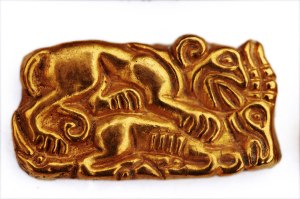Now, until I studied A Level Archaeology, I had believed a kurgan to be a villain from the 1986 film ‘Highlander’:
However, I am now older and slightly wiser, and can see the fascinating insights that these kurgans in their archaeological sense can provide us with. I can across an article earlier today on a Sarmatian kurgan excavated in the Russian Southern Ural steppes by the Institute of Archaeology (Russian Academy of Sciences), and it is truelly amazing what has been discovered. Until this point, I did not really know anything about Russian (or indeed any European) nomads except that some actually practised tattooing several millenia ago, but this find from the 1st millennium BC is the Iron Age equivelant to our own dear Sutton Hoo. These Sarmatians and other nomads called Scythians interacted with both Persian and Classical Greek culture whilst managing to retain their own distinct style that can be illustrated in some of the amazing artifacts uncovered from this recently-excavated kurgan. The finds are believed to suggest that this burial contained a woman- assuming that you subscribe to the dated and gender stereotyped view of 1970’s archaeological theory that women can be identified in the burial record by jewellery and mirrors. Osteological indications suggest a man, however, and I would be more inclined to believe this, to be honest.

The burial chamber showing the body, and some of the grave goods. The mirror is visible to the middle right of the image, and the silver container on the top left. Image: Leonid Yablonsky.
Apparently, this particular mound had been excavated 20 years ago and had revealed 26 “golden” deer statuettes, but the section unearthed this year had been left unexplored. In a passage near the enterance the team found a cast bronze cauldron with a diameter of 102 cm, with handles decorated in a Scythian-Siberian animal style showing two griffins beak-to-beak:
Within the intact burial chamber, which measured 4x5m and was 4m deep, there was found a skeleton, and near to the skull, a wicker chest. This may have been a ‘vanity case’, and was filled with items including: a cast silver container with a lid; a gold pectoral; a wooden box; cages; glass; silver and earthenware bathroom flasks; leather pouches and horse teeth containing red pigments. There was also a large silver mirror, as well as items of clothing decorated with several plaques that showed flowers, rosettes and a panther leaping on a saiga’s (antelope) back. Breeches, a shirt and a scarf were found to have 395 pressed pieces of gold leaf sewn onto them, with the shirt having its sleeves embellished with multicoloured beads, and a fringed shawl was held together with a golden chain. Also, two cast gold earrings were decorated in places with cloisonné enamel and found on the skeleton, suggesting that they had been worn on the corpse. Less ornate were two stone mixing palettes that were discovered, along with gold-plated iron needles and bone spoons and pens decorated with animals- but it is believed that these were used to carry out tattooing. In all, there were over 1000 artifacts uncovered, and a few can be seen below:
This excavation has certainly opened my eyes to a society that I previously knew next to nothing about, and has certainly excited me to find out more about these Iron Age peoples. A couple of days of research are in order over the next few weeks, I think.!







